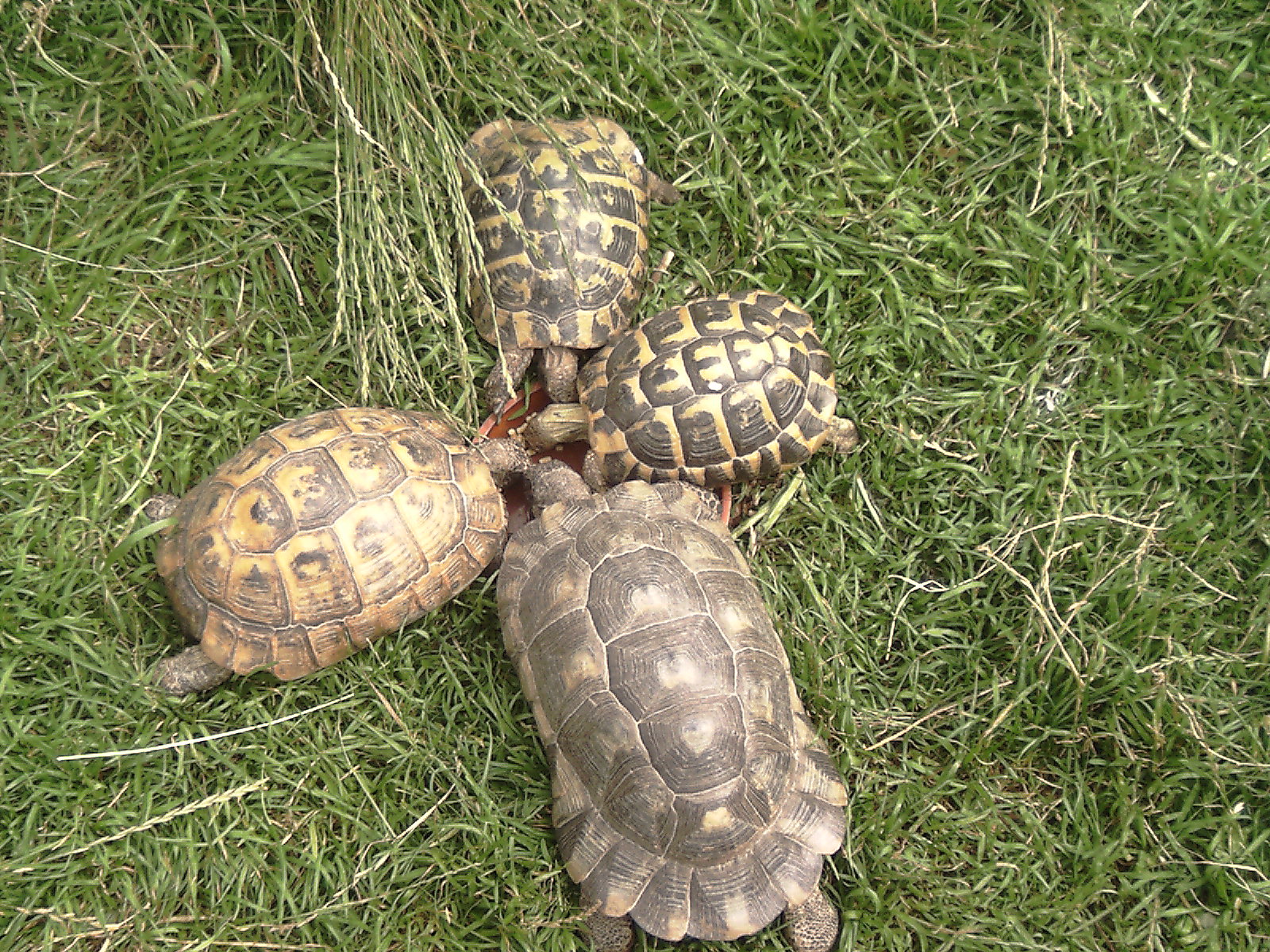- Testudo (genus)
image_width = 250px
image_caption = Four tortoises of the genus "Testudo". Clockwise from left: "Testudo graeca ibera" "Testudo hermanni boettgeri" "Testudo hermanni hermanni" "Testudo marginata sarda".
name = "Testudo"
regnum =Animal ia
phylum =Chordata
classis =Sauropsida
subclassis =Anapsida
ordo =Testudines
subordo =Cryptodira
superfamilia =Testudinoidea
familia =Testudinidae
genus = "Testudo"
genus_authority = Linnaeus,1758
subdivision_ranks =Species
subdivision = Several, see text.
synonyms ="Chersus" Gmira,1993
"Furculachelys" Highfield,1990 Verify source|date=July 2007 and see text."Testudo" is a
genus oftortoise s found in North Africa, western Asia, and Europe. Several species are under threat in the wild, mainly from habitat destruction.They are small tortoises, ranging in length from 7 cm to 35 cm and in weight from 0.7 kg to 7 kg, although the extinct "T. atlas"Verify source|date=February 2008 reached 2.5 m. Like most tortoises, they are
herbivorous .ystematics
The
systematics andtaxonomy of "Testudo" is notoriously problematic. Highfield & Martin commented:Synonymies on "Testudo" are notoriously difficult to compile with any degree of accuracy. The status of species referred have undergone a great many changes, each change introducing an additional level of complexity and making bibliographic research on the taxa extremely difficult. Most early and not a few later checklists contain a very high proportion of entirely spurious entries, and a considerable number of described species are now considered invalid - either because they are homonyms, non-binomial or for some other reason. [Highfield & Martin (1989)]
Since then,
DNA sequence data has increasingly been utilized in systematics, but in Testudines (turtles and tortoises) its usefulness is limited: In some of these, at leastmtDNA is known toevolve more slowly in these than in most other animals. [Avise "et al." (1992)]Paleobiogeographical considerations suggest that the rate of evolution of the mitochondrial12S rRNA gene is 1-1.63% per million years for the last dozen million years or so in the present genusvan der Kuyl "et al." (2002)] and ntDNA evolution rate has been shown to vary strongly even between different population of "T. hermanni";Fritz "et al." (2006)] this restricts sequence choice formolecular systematics and makes the use ofmolecular clock s questionable.Conventionally, 5 species are placed here:
*Russian Tortoise or Horsfield's Tortoise, "Testudo horsfieldii"
*Hermann's Tortoise , "Testudo hermanni"
*Greek Tortoise or Spur-thighed Tortoise, "Testudo graeca"
** "Maghreb Tortoise", "Testudo (graeca) graeca"
** Greek Tortoise, "Testudo (graeca) ibera"
** "Persian Tortoise", "Testudo (graeca) zarudnyi"
*Kleinmann's Tortoise or Egyptian Tortoise, "Testudo kleinmanni"
*Marginated Tortoise . "Testudo marginata"The first two are more distinct and ancient lineages than the closely-related latter 3 species. It was argued that "T. horsfieldii" belonged in a new genus ("Agrionemys") on the basis of the shape of its
carapace andplastron , [Khozatsky & Mlynarski (1966)] and its distinctness is supported byDNA sequence analysis. [e.g. Fritz "et al." (2005)] Likewise, a separate genus "Eurotestudo" has recently been proposed for "T. hermanni"; these three lineages were distinct by theLate Miocene as evidenced by the fossil record. [de Lapparent de Broin "et al." (2006)] Whether these splits will eventually be accepted remains to be seen . The genus "Chersus" has been proposed to unite the Egyptian and Marginated Tortoises which have certain DNA sequence similarities, but their ranges are (and apparently always were) separated by their closest relative "T. graeca" and the open sea and thus, chance convergenthaplotype sorting would better explain thebiogeographical discrepancy.On the other hand, the Greek Tortoise is widespread and highly diverse. In this and other species, a high number of
subspecies has been described, but not all generally accepted, and several (such as the "Negev Tortoise " and the "Dwarf Marginated Tortoise ") are now considered to be local morphs. Some, such as theTunisian Spur-thighed Tortoise , have even been separated as a spearate genus "Furculachelys", but this is not supported by more recent studies. [van der Kuyl "et al." (2005)] However, it is likely that the "Greek" Tortoise will be split into two or more species in the near future.Footnotes
References
* (1992): Mitochondrial DNA evolution at a turtle's pace: evidence for low genetic variability and reduced microevolutionary rate in the Testudines. "Mol. Biol. Evol." 9(3): 457-473. [http://mbe.oxfordjournals.org/cgi/reprint/9/3/457.pdf PDF fulltext]
* (2006): "Eurotestudo", a new genus for the species "Testudo hermanni" Gmelin, 1789 (Chelonii, Testudinidae). [English with French abstract] "C. R. Palevol" 5(6): 803-811. doi|10.1016/j.crpv.2006.03.002 [http://www.landskildpadde.dk/Lapparent%20de%20Broin%20et%20al_2006_Eurotestudo_for_Testudo%20hermanni.pdf PDF fulltext]
* (2005): Environmentally caused dwarfism or a valid species - Is "Testudo weissingeri" Bour, 1996 a distinct evolutionary lineage? New evidence from mitochondrial and nuclear genomic markers. "Mol. Phylogenet. Evol." 37(2): 389–401. doi|10.1016/j.ympev.2005.03.007 [http://www.uni-heidelberg.de/institute/fak14/ipmb/phazb/pubwink/2005/07.2005.pdf PDF fulltext]
* (2006): A rangewide phylogeography of Hermann's tortoise, "Testudo hermanni" (Reptilia: Testudines: Testudinidae): implications for taxonomy. "Zool. Scripta" 35(5): 531-548. doi|10.1111/j.1463-6409.2006.00242.x [http://www.uni-heidelberg.de/institute/fak14/ipmb/phazb/pubwink/2006/04.2006.pdf PDF fulltext]
* (1989): A revision of the Testudines of North Africa, Asia and Europe. Genus: "Testudo". "Journal of Chelonian Herpetology" 1(1): 1–12. [http://www.tortoisetrust.org/articles/testudo.html HTML fulltext]
* (1966): "Agrionemys" - nouveau genre de tortues terrestres (Testudinidae) ["Agrionemys" - a new genus of tortoises"] . [Article in FrenchVerify source|date=February 2008 ] "Bulletin de l'Académie Polonaise des Sciences II - Série des Sciences Biologiques" 2: 123-125.
* (2002): Phylogenetic Relationships among the Species of the Genus "Testudo" (Testudines: Testudinidae) Inferred from Mitochondrial 12S rRNA Gene Sequences. "Mol. Phylogenet. Evol." 22(2): 174–183. doi|10.1006/mpev.2001.1052 (HTML abstract)
* (2005): Mitochondrial haplotype diversity in the tortoise species "Testudo graeca" from North Africa and the Middle East. "BMC Evol. Biol." 5: 29. doi|10.1186/1471-2148-5-29 (HTML/PDF fulltext + supplementary material)
Wikimedia Foundation. 2010.

